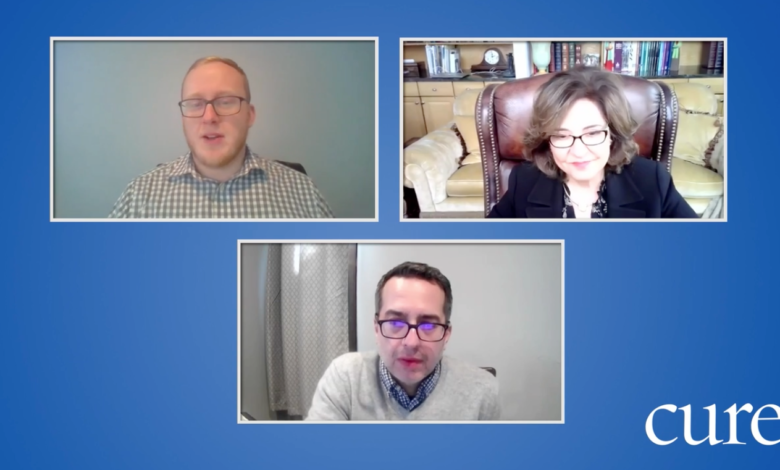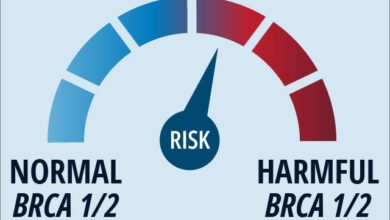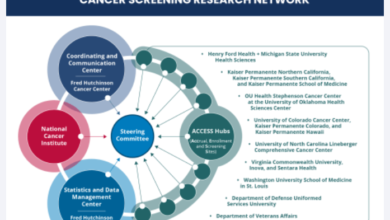Educated Patient® MPN Summit Polycythemia Vera Panel: November 19, 2022

This panel was moderated by Ryan McDonald and featured Dr. Jamile Shammo, from Northwestern Medicine, and Dr. John Mascarenhas, from Mount Sinai, who answered questions about polycythemia vera (PV).
McDonald: Dr. Shammo, I’d like to start off with you. First, we had a question from the audience asking what are adequate triggers to perform a bone marrow biopsy? And how often is perhaps too often for a patient to go through this?
Shammo: That’s a good question. So I’m assuming that this pertains to patients who are on therapy, not necessarily at the time of diagnosis, because you may or may not need to do it to make a diagnosis. But I usually think about this, if I have any concern that maybe my patient’s disease has progressed. Now there is something also called the peripheral smear. So that could also be something that we would monitor to help us decide when a bone marrow biopsy is needed. So if you start to see certain features on the peripheral smear, like what we call local retro blasting picture, essentially abnormal bone marrow, cells that don’t belong in the peripheral blood, that would be grounds for doing that, if I feel like my patient is starting to lose weight, I’m concerned about enlarging the spleen. Despite treatment, well, that may be one other way to do it. And I think the bottom line is that the bone marrow would show me that this disease as you progress further to what we call myelofibrosis. There is only one way to do that is by demonstrating enough reticulate fibrosis, on some stain in the bone marrow and by looking at it so if you really don’t do the marrow, you’re going to miss developing myelofibrosis. And of course, there’s a lot more nuances that go into the diagnosis. But essentially, any change in the clinical status prompts me to do this. And yes, we probably should not be doing it unless there’s very good reason to perform it because you have a peripheral smear to guide you.
McDonald: Okay, perfect. Dr. Mascarenhas, we have a question about disease progression in PV. And one of them, and there’s probably other aspects of this, obviously, but one person was curious as to what effect does DMMT3A play on progression?
Mascarenhas: So, you know, in today’s world, it’s not uncommon that physicians will get what’s called next generation sequencing, which is looking at a set of genes on a panel and seeing if there’s a panel that’s relevant to the disease, I should say, a gene panel that’s relevant to disease and seeing if any of those genes are mutated, because we do see increasingly mutations and alterations in genes other than JAK mutation that could influence the behavior of the disease. And we use a phrase called clonal evolution, meaning that over time, and we don’t know why exactly, but certain patients and in their disease will get clonally complex subclones will go out that are driven by certain mutations. DMMT3A can be one of those mutations.
And we, in the setting of research, that’s also very important to try to understand the biology and how to intervene appropriately. But I will be honest, in the setting of clinical care, it has to be understood in the context of the clinical features more than the genomic features. So although I’m definitely someone who looks at those very carefully, and is intrigued by them, we don’t treat the mutations we treat the patients, you have to understand whether the patient’s DMMT3A mutation is also associated with other clinical features that could suggest progression of disease before you act on it.
We do know that these mutations have some prognostic significance. So sometimes, that might influence decision making. But I’m very careful. And as you notice, I’m dancing around it because I would never dare to give direct advice to that patient who’s asking a very good question, because there’s so much to be considered. And I would never act on a DMMT3A mutation in isolation, you really need to know the whole clinical picture, you need to understand what are the goals of that patient’s care, and how to plan accordingly, but I would look at those mutations very carefully.
We know certain mutations are deleterious and others are favorable, and many are intermediate, which means they don’t tell us one way or the other. But what we don’t always know is how to act or behave with those mutations. So sometimes the mutations induce a lot of anxiety, but don’t always translate to actionable interventions by the physician. So they are bittersweet, and there’s still a lot of research that needs to be done so we know how to really integrate them in an effective manner in our treatment approach.
McDonald: A follow-up to that Dr. Mascarenhas. You said there’s a lot that goes into it right? So how do you talk with your patients about their concerns?
Mascarenhas: You mean concerns of the patient of what might lay ahead of them? I think living with so this is a prime example. And not particularly to PV necessarily, but living with a chronic disease has its own baggage literally and figuratively. It has its own baggage because you don’t always know this concept of when the shoe may drop, I think is very relevant here. You don’t always know what’s next. That in itself can be very disconcerting you know. It’s almost better in some ways to not know what you’ve gotten, what you’re dealing with, because then you just kind of live your life. The problem with PV is it’s like an albatross. It sits over your shoulder, affects you in ways that might be obviously not obvious. You’re planning for your life events, your finances, your whole thing, it takes a huge toll. And maybe not everyone always appreciates that, because what I’ve often gotten a complaint for many years now that it really always hits me is patients with PV will be very frustrated, because often, family members and friends will say, “Well, you look fine. You don’t look sick, like how sick can you actually be?” And that’s not very comforting when you don’t have that same empathy and validation from those around you. If you have breast cancer, colon cancer, that’s a disease that people can relate to, they can understand. And I think there’s often a reaction in response to patients who have those diseases that that provides them some sense of community and support and understanding. Whereas PV is very vague to many patients. And patients can often look good, but not feel well. And that can be very upsetting when patients don’t feel well with these diseases and have these natural anxieties about what the future might look like. And that can really take its toll how to deal with that.
I think you have to get paired up with a physician who listens, who’s compassionate, who is on top of their game, who’s attuned to what PV is, and how to manage it, and how to optimize the situation. And importantly, you need to voice that to the physician because sometimes patients come in, and for various reasons, they may not always speak up and tell the physician what’s bothering them physically, emotionally. And from a system perspective in what they’re looking to achieve, you want to make sure that that physician engages with that and then has a treatment plan that makes sense compared to what you are looking to achieve. And I think that brings a lot of satisfaction, I think it does to patients when that is met.
McDonald: Thank you. And Dr. Shammo, we had a question which kind of relates to the last presentation about age. So someone asked about high-risk polycythemia vera and if age matters and deciding how the disease is treated.
Shammo: So I think someone in the prior presentation also brought up concomitant or other factors that might influence risk for thrombosis, other than age and prior thrombosis event. So not too long ago, actually, I saw someone in the clinic who happened to be 59, but they had diabetes, high blood pressure and hyperlipidemia. So technically speaking, if I really went by the risk, the proposed or what we typically utilize in clinical care, they don’t have it because they’ve never had it, but do I feel like absolutely they do. So I mean, I think that those are numbers that were derived from clinical trials that showed you that patients who had those two risk factors – age and have a higher risk – but for an individual patient, I think they have to be evaluated on a one-by-one basis. So this patient, the 59 year old, I consider them high risk, and they were treated as such. I hope that answered the question.
McDonald: Dr. Mascarenhas, what about combination therapy? Where does this play a role in polycythemia vera?
Mascarenhas: So it’s a great question. I kind of alluded to it in one of the slides. I do think that the future is likely to hold combination therapy approaches. We’re seeing increasingly now in myelofibrosis and a lot of times what you see in myelofibrosis then trickles down to polycythemia vera or essential thrombocythemia I think the idea of combining drugs. So a prime example would be interferon interference and active drugs. And as Dr. Shammo pointed out, if the initial formulations can turn were really difficult to tolerate. And I got a little taste of that when I first entered the field, it’s really different now than it was before. But there’s still more that can be done. And interferon I think it forms a great combinatorial partner for a lot of these drugs that I sort of highlighted, whether it’s drugs that affect the epigenome or drugs that try to induce apoptosis. And a lot of preclinical data was suggested if you combine the two drugs, you really get more bang for your buck and really get deeper responses and more modulation of that stem cell. So I think what you will see and you’re starting to see it actually so in Europe, they’ve been a little ahead of us in that way and combining interferon with Jakafi, that’s not It’s not intuitive, but combining interferon with Jakafi in patients with myelofibrosis, ET and PV, and the results that are coming out of those trials are also encouraging. So I think, you know, stay tuned. That is where this is going to go and like most of oncology combination therapies tend to provide deeper responses hopefully with more direct impact on the patient.
Transcription was edited for clarity.
For more news on cancer updates, research and education, don’t forget to subscribe to CURE®’s newsletters here.
Source link
#Educated #Patient #MPN #Summit #Polycythemia #Vera #Panel #November



